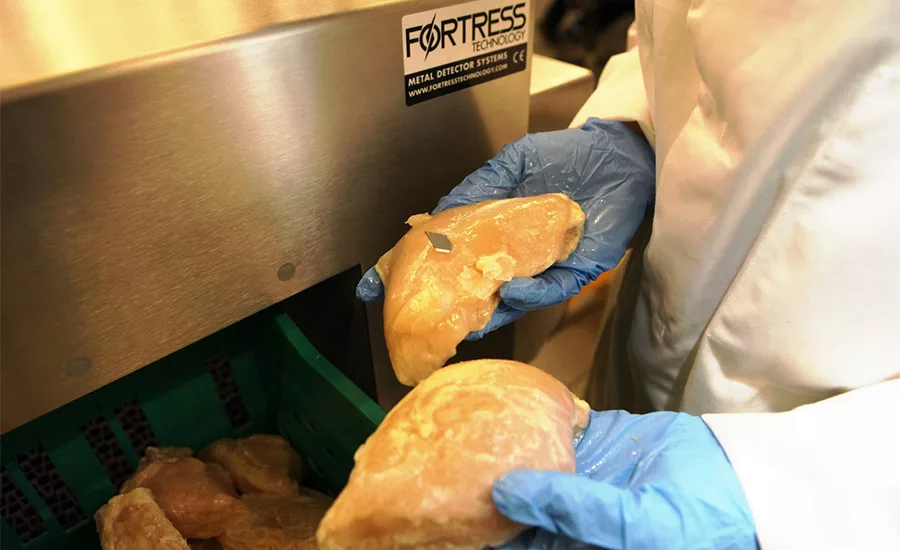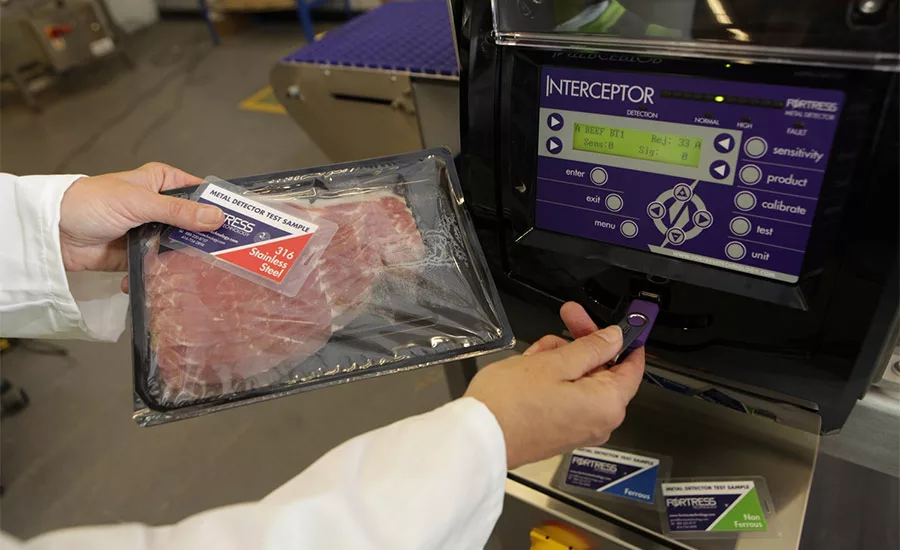Inspection Systems
Some pointers on choosing metal detection systems to keep food safe from adulteration
While meeting FDA, SQF, CFIA and BRC requirements is important, regulatory agencies are no longer judge and jury in this world of social media



In the engineering world, it has often been said that you can’t inspect quality into a product. Rather, you design and build quality into a product and then inspect to make sure you are delivering what you promise.
In the food and beverage industry, your product quality—and safety—has far more personal ramifications than, say, a newly designed phone or network switch. You do your best to ensure that your food product meets all your quality specifications and food safety regulatory requirements before the product goes out the door. And while your product goes out the door free of pathogens, there could be other potential problems—for example, metal contaminants or foreign objects—that could ruin a customer’s day, your day, your product’s reputation and/or your company.
Changes to food safety are largely driven by U.S. legislation, says Steve Gidman, founder and president of Fortress Technology, a provider of metal detection systems. Most countries are now converging towards FDA’s FSMA standards. Most important with FSMA is that it shifts the focus of food companies from responding to foodborne illness to taking steps to prevent it. This, according to Gidman, is driving the adoption of track and trace technologies, with foreign imports a focus in the FDA’s plans.
Under FSMA, the long-standing HACCP protocols (especially the “critical control points” part of it) have been superseded by risk-based preventive controls—once known as “HARPC.” The biggest difference is that risk-based preventive controls standards extend beyond HACCP’s Critical Control Points. “Food processors must document all potential product risks, including planning for potential terrorist acts, intentional adulteration and food fraud,” says Gidman.
Canada also updated its food safety system at the start of 2019, implementing its new Safe Foods for Canadians (SFC) Regulations. As well as affecting the Canadian food industry, it requires companies that export to Canada, especially the United States, to have a SFC license. Canada’s new rules place greater emphasis on hygiene and hazardous-based preventative controls. This includes a new standard on recording the chain of custody from the start of production to point of sale.
Consumers and retailers rule
Food producers and packers clearly need to comply with legislative requirements. But in reality, it is supermarkets and club stores who are driving food safety compliance right down the food chain—a trend that is partly due to the power consumers now wield through social media, says Gidman. In the event of a food safety incident, an individual consumer may not even bother to take up the issue with the retailer or food producer, instead going straight to social media. As a result, supermarkets, too, are taking food safety matters into their own hands and insisting that all suppliers install metal detection if they are to retain shelf space.
It is a trend that is also being played out in Europe, particularly in the UK, where retailer codes of practice (COP) are king. Issue 8 of the British Retail Consortium’s Global Food Safety Standard went live in 2019. With this latest version, there is a strong emphasis on hygiene and pathogen contamination.
Looking for quick answers on food safety topics?
Try Ask FSM, our new smart AI search tool.
Ask FSM →
Inspection strategies help processors to stay ahead of the curve
FSMA concerns itself primarily with bacterial contamination of incoming ingredients from suppliers. Nevertheless, foreign materials in food also fall under FSMA scrutiny in its adulteration rules—so processors may want to be sure ingredients are safe by implementing incoming inspection systems. This raises the question: Should food processors be implementing incoming inspection systems, for example, for flour or sugar to be sure metal fragments or other foreign bodies are not in the material?
"There is always value to adding up-stream detection to most any process," says Gidman. The incoming materials should be inspected when leaving the supplier, but this may not be guaranteed. Catching contaminants sooner may mean a single reject of a relatively easy-to-detect contaminant, versus a multitude of down-stream rejects on finished product, or finished product containing undetectable fragments of the contaminant once broken down into smaller fragments as it makes its way through the process. The other added benefit is to know that the contaminant comes from outside the process. In this case, either the transport company or the supplier may be lacking controls.
If a processor decides to implement incoming ingredient inspection, should both metal and X-ray detection systems be used? Can X-ray systems miss certain metal fragments?
This will highly depend on the contaminant risk and the product characteristics as it is presented to the inspection equipment, says Gidman. X-ray inspection systems essentially identify contaminants based on density relative to the product being inspected. Because of this, low density alloys are can be especially difficult to detect. X-ray sensitivities can also be adversely affected where product density and presentation are variable. For these reasons metal detection should be the go-to technology, says Gidman.
Beyond eliminating any pathogenic substances in food and beverage products, food processors and packagers should take five key steps to implement end-of-line inspection systems to ensure that physical, metallic contaminants are not in a product, says Gidman. Today’s inspection systems have seen several improvements, which make them an important part of an overall defect monitoring system.
Some food companies have thrown both X-ray and metal detection systems at end-of-line inspection. But, is this really necessary—especially if using incoming ingredient inspection systems?
If it was a necessity, then everyone would do it, says Gidman. However, the two technologies do complement each other, and will effectively detect more contaminates when used together. However, incoming ingredient inspection does not circumvent the need for end-of-line contaminant detection because contamination is just as likely to come from within a process.
Selecting an inspection system
Gidman’s recommendations consist of five steps in choosing inspection systems. They are as follows:
1. Contaminant detection: choose a kit that reflects the risk.
To determine whether metal detection or X-ray is the best option, food manufacturers should first establish the potential sources of contamination on the particular product line. In most instances, metal remains the most common contaminant. Obviously, grinding, cutting or stirring equipment could release metal flakes into a product.
Plastic parts can be difficult to detect. Even “metal detectable” plastics should be tested on all downstream metal detectors on the setting used while inspecting product. The results can vary quite greatly depending on the characteristics of the product running on the metal detection system. Generally for best results, the doping agent used for the plastic should cause a disturbance dissimilar to the product effect of what is being inspected.
2. Select inspection equipment with inbuilt record keeping capabilities
Today’s inspection systems often include built-in logging software. “Contact Reporter” software is an automated record keeper developed by Fortress to help food processors keep track of and record logs for rejects, tests and settings. This facilitates the documenting of potential product risks and helps to narrow the time frame during which a problem can go undetected, and reduces the amount of suspect product that must be discarded or recalled in the event of an incident.
3. Check that metal detection systems are failsafe
If a fault with the reject system means that a contaminant is detected but not rejected, the line should stop automatically until the situation is resolved. Both detector performance and fail-safe capability should be tested regularly, ideally using an automated test system to eliminate human error, with results kept on record to support traceability.
4. Minimize false rejects
False rejects are the biggest threat in terms of line downtime and product waste. You want to be sure that when you stop the line because of detected metal, there is really an issue to address. Fortress’ simultaneous multi-frequency technology, available on its Interceptor metal detector, enables producers of conductive products like meat, dairy and prepared foods to combine maximum detection sensitivity with minimal false rejects. For more on this subject, visit “Metal detectors good at finding 3D but struggle with flat flakes,” FE Engineering R&D, August 2019.
5. Get compliant and stay compliant
Inspection equipment suppliers should be actively finding ways to extend the product lifecycle of inspection equipment. For example, the Fortress Never Obsolete Commitment helps customers stay compliant with future retailer COP curveballs. A backward-compatibility program, it enables customers to upgrade any existing Fortress metal detector—even those built 20 years ago. An upgrade as a result of a change to a retailer COP will only set a processor back several hundred rather than thousands of dollars.
For more information, visit the Fortress website.









